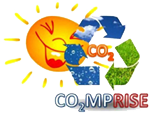 The Helmholtz-Zentrum Geesthacht is a non-profit making research institute with limited liability. Its shareholders are the Federal Republic of Germany, the federal states (Länder) of Brandenburg, Hamburg, Lower Saxony and Schleswig-Holstein, the Gesellschaft zur Förderung des Helmholtz-Zentrums Geesthacht e.V. (Society for the Promotion of the Helmholtz-Zentrum Geesthacht) as well as a number of renowned companies. The centre is based in Geesthacht, Germany. In 1992, the Working Group Teltow became a part of it. The Helmholtz-Zentrum Geesthacht is a member of the Helmholtz Association of German Research Centres.
The Helmholtz-Zentrum Geesthacht is a non-profit making research institute with limited liability. Its shareholders are the Federal Republic of Germany, the federal states (Länder) of Brandenburg, Hamburg, Lower Saxony and Schleswig-Holstein, the Gesellschaft zur Förderung des Helmholtz-Zentrums Geesthacht e.V. (Society for the Promotion of the Helmholtz-Zentrum Geesthacht) as well as a number of renowned companies. The centre is based in Geesthacht, Germany. In 1992, the Working Group Teltow became a part of it. The Helmholtz-Zentrum Geesthacht is a member of the Helmholtz Association of German Research Centres.
At the Institute of Materials Research at the Helmholtz Zentrum Geesthacht in Geesthacht more than 160 employees work in the 5 research divisions, " Materials Mechanics", "Materials Physics", "Materials Technology ", "Magnesium Innovation Center Magic", and “Metallic Biomaterials”.
Embedded in the Helmholtz Research Fields "Key Technologies" and "Structure of Matter" the Geesthacht scientists at the Institute of Materials Research develop ultra-light-weight materials and innovative process technologies for the application areas air and ground transportation, implantology and regenerative medicine, as well as energy storage and conversion.
The division Materials Technology works on selected applications of hydrogen and of nano technology. It works interdisciplinary and across department boarders in close coordination with other research activities at the Helmholtz-Zentrum Geesthacht, with other Helmholtz centres and with universities as the Helmut-Schmidt University, Hamburg, the Hamburg University of Technology, and the University of Hamburg.
For the future hydrogen economy the cost-effective production of hydrogen and its energy efficient and cost saving storage at the lowest possible pressures, moderate temperatures and high capacity are essential prerequisites. To meet challenges of characterization of novel materials with X-ray and neutron diffraction techniques, highly reflective optics are needed that are based on specific nanostructured coatings. Modern lightweight materials such as magnesium must be protected by coatings against corrosion.
Research Topics
The division Materials Technology focuses its activities on the following topics:
- Nanostructured semiconductor surfaces for photoelectrochemical production of hydrogen by sun light (Dept. Sustainable Energy Technology)
- Nanocrystalline light metal hydrides and hydride composites for solid state hydrogen storage: Development, optimisation, scale-up of materials production and evaluation of novel hydrogen storage materials, hydrogen storage tank design and test (Dept. Nanotechnology)
- Deposition of nanostructured thin layers for corrosion protection and for X-ray and neutron optics (Dept. Nanotechnology)
Contact Person at HZG
Dr. Claudio Pistidda, Institute of Materials Research, WTN
Phone: +49 (0)4152 87-2644
E-mail contact claudio.pistidda@hzg.de

